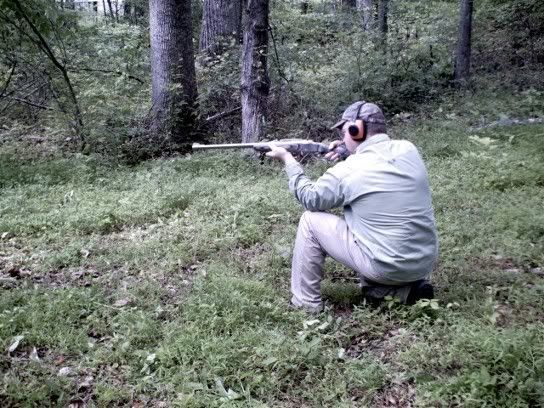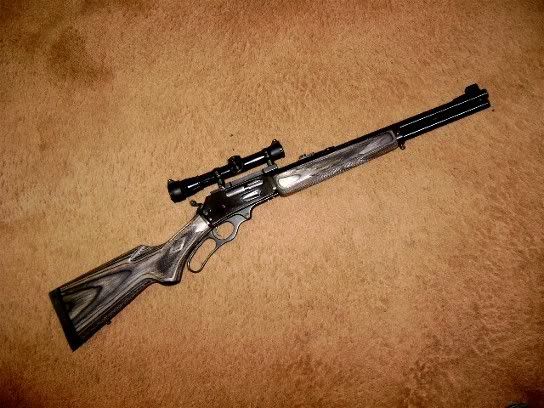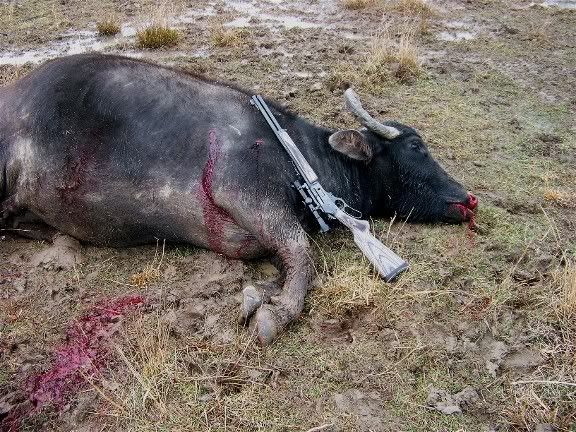It will take a while to get all the data here. It was fun.
Test overview from .416 vs. .450 5/17/07
In this test I decided to use the toughest media I know of which is dry vinyl coated paper. It will generally destroy bullets and penetration is very limited. The two rifles are as different as they can possibly be. The .450 marlin guide gun is a lightweight short barreled lever action. The .416 Rigby a Ruger #1 Tropical SS/ laminate. Typically the .416 makes its living by generating around 5000flbs of muzzle energy.
First off many would consider this a David and Goliath test but nothing could be farther from the truth. The fact of the matter is when fired into dampened media the .458 Nosler 300gr PP generally out penetrates bullets that weigh more than it does even when fired at slower speeds. This has been proven over and over. In my previous testing I discovered that as media tensile strength rises the bullets of similar construction generating more kinetic energy did have an advantage so to my way of thinking pitting a rifle generating around 3000flbs against one generating around 5000ftlbs would help to establish if the 300gr Nosler was truly as good as it acted in softer medias.
The method used for determining penetration and wound channel score was as follows. After the shot the media was examined to determine the position of the bullet and that stack of media would be removed to that point and placed back flat on the surface of the ballistic buffalo and measured. The wound channel observations were made in layers to determine how quick expansion started, peaked and subsided. Since the dry media wouldn't hold the shape of the wound channel like the damp media no true wound volume could be established but reason able description of the damage could be easily observed.
The bullets were removed, measured and weighed. General observations were made on the condition of the bullets. All of the results are free from bias.
Bullet test 5/17/07
.416 Rigby vs. .450 Marlin in dry vinyl coat media
.458 Nosler PP 300gr
Velocity: 2100fps
Energy: 2938flbs
Penetration: 5.00"�
Weight: before shot 300grs
After shot 220.00grs
Expanded diameter: .631"�
.416 Barnes X 300gr
Velocity: 2650fps
Energy: 4679flbs
Penetration: 5.25"�
Weight: before shot 300grs
After shot 299.4grs
Expanded diameter: .849"�
.416 Barnes X 350gr
Velocity: 2600fps
Energy: 5254flbs
Penetration: 6.0"�
Weight: before shot 349.4grs
After shot 349.0grs
Expanded diameter: .807"�
.416 Nosler partition
Velocity: 2450fps
Energy: 5332flbs
Penetration: 7.75"�
Weight: before shot 400grs
After shot 329.40grs
Expanded diameter: .784"�
Test Results
1. The 300gr .458 Nosler fired at 2100fps
The bullet exhibited expansion within 1.5"� of entering the media. The immediate wound channel was large and this bullet removed the second largest amount of media from its path. The expansion was full by 2.5"� of travel in the media where it left the largest diameter hole of all the bullets tested which was approximately 2.75" . At this point it appeared to loose its petals and continued on leaving a decent wound channel probably because of the very flat nose it had with out the petals. This bullet retained the least amount of its original weight but this didn't seem to affect its ability to penetrate.
2. The 300gr .416 Barnes X fired at 2650fps
The bullet exhibited expansion 2"� after entering the media. The bullet appeared to reach full expansion instantly. The wound channel was approximately the same size to slightly larger than the expanded bullet. It appeared more to cut the media than to explode it. The petals all remained attached to the bullet. This bullet retained over 99% of its original weight.
3. The 350gr .416 Barnes X fired at 2600fps
The bullet exhibited expansion 2"� after entering the media. The bullet appeared to reach full expansion immediately. The wound channel was the 3rd largest and did exhibit some explosive reaction to the media at one point leaving a 1.25"� diameter path. The bullet possibly because of the amount of energy it struck the target with generated the second largest reaction from the holder. This bullet retained over 99% of its original weight.
4. The 400gr .416 Nosler Partition
The bullet exhibited expansion within 1.5"� of its entrance into the media. The wound channel was very large and tubular as the bullet removed media the whole length of its penetration exhibiting tremendous trauma to the media and holder. Upon impact the whole ballistic buff reacted. This bullet generated the greatest amount of kinetic energy. Upon removal it was discovered that great pressure from impacting the hard media had caused the bullet to squat slightly at the partition. This bullet penetrated the farthest and did the most damage. The bullet retained 82.4% of its original weight.
the two cartridges
![Image]()
the two rifles
![Image]()
the cartridges and bullets
![Image]()
me with the 450
![Image]()
me with the .416
![Image]()
Test overview from .416 vs. .450 5/17/07
In this test I decided to use the toughest media I know of which is dry vinyl coated paper. It will generally destroy bullets and penetration is very limited. The two rifles are as different as they can possibly be. The .450 marlin guide gun is a lightweight short barreled lever action. The .416 Rigby a Ruger #1 Tropical SS/ laminate. Typically the .416 makes its living by generating around 5000flbs of muzzle energy.
First off many would consider this a David and Goliath test but nothing could be farther from the truth. The fact of the matter is when fired into dampened media the .458 Nosler 300gr PP generally out penetrates bullets that weigh more than it does even when fired at slower speeds. This has been proven over and over. In my previous testing I discovered that as media tensile strength rises the bullets of similar construction generating more kinetic energy did have an advantage so to my way of thinking pitting a rifle generating around 3000flbs against one generating around 5000ftlbs would help to establish if the 300gr Nosler was truly as good as it acted in softer medias.
The method used for determining penetration and wound channel score was as follows. After the shot the media was examined to determine the position of the bullet and that stack of media would be removed to that point and placed back flat on the surface of the ballistic buffalo and measured. The wound channel observations were made in layers to determine how quick expansion started, peaked and subsided. Since the dry media wouldn't hold the shape of the wound channel like the damp media no true wound volume could be established but reason able description of the damage could be easily observed.
The bullets were removed, measured and weighed. General observations were made on the condition of the bullets. All of the results are free from bias.
Bullet test 5/17/07
.416 Rigby vs. .450 Marlin in dry vinyl coat media
.458 Nosler PP 300gr
Velocity: 2100fps
Energy: 2938flbs
Penetration: 5.00"�
Weight: before shot 300grs
After shot 220.00grs
Expanded diameter: .631"�
.416 Barnes X 300gr
Velocity: 2650fps
Energy: 4679flbs
Penetration: 5.25"�
Weight: before shot 300grs
After shot 299.4grs
Expanded diameter: .849"�
.416 Barnes X 350gr
Velocity: 2600fps
Energy: 5254flbs
Penetration: 6.0"�
Weight: before shot 349.4grs
After shot 349.0grs
Expanded diameter: .807"�
.416 Nosler partition
Velocity: 2450fps
Energy: 5332flbs
Penetration: 7.75"�
Weight: before shot 400grs
After shot 329.40grs
Expanded diameter: .784"�
Test Results
1. The 300gr .458 Nosler fired at 2100fps
The bullet exhibited expansion within 1.5"� of entering the media. The immediate wound channel was large and this bullet removed the second largest amount of media from its path. The expansion was full by 2.5"� of travel in the media where it left the largest diameter hole of all the bullets tested which was approximately 2.75" . At this point it appeared to loose its petals and continued on leaving a decent wound channel probably because of the very flat nose it had with out the petals. This bullet retained the least amount of its original weight but this didn't seem to affect its ability to penetrate.
2. The 300gr .416 Barnes X fired at 2650fps
The bullet exhibited expansion 2"� after entering the media. The bullet appeared to reach full expansion instantly. The wound channel was approximately the same size to slightly larger than the expanded bullet. It appeared more to cut the media than to explode it. The petals all remained attached to the bullet. This bullet retained over 99% of its original weight.
3. The 350gr .416 Barnes X fired at 2600fps
The bullet exhibited expansion 2"� after entering the media. The bullet appeared to reach full expansion immediately. The wound channel was the 3rd largest and did exhibit some explosive reaction to the media at one point leaving a 1.25"� diameter path. The bullet possibly because of the amount of energy it struck the target with generated the second largest reaction from the holder. This bullet retained over 99% of its original weight.
4. The 400gr .416 Nosler Partition
The bullet exhibited expansion within 1.5"� of its entrance into the media. The wound channel was very large and tubular as the bullet removed media the whole length of its penetration exhibiting tremendous trauma to the media and holder. Upon impact the whole ballistic buff reacted. This bullet generated the greatest amount of kinetic energy. Upon removal it was discovered that great pressure from impacting the hard media had caused the bullet to squat slightly at the partition. This bullet penetrated the farthest and did the most damage. The bullet retained 82.4% of its original weight.
the two cartridges
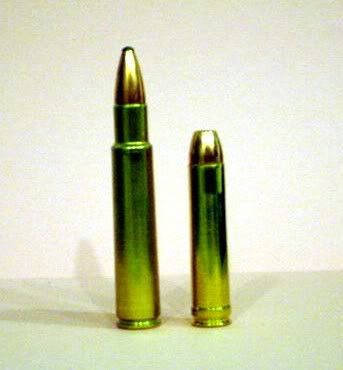
the two rifles
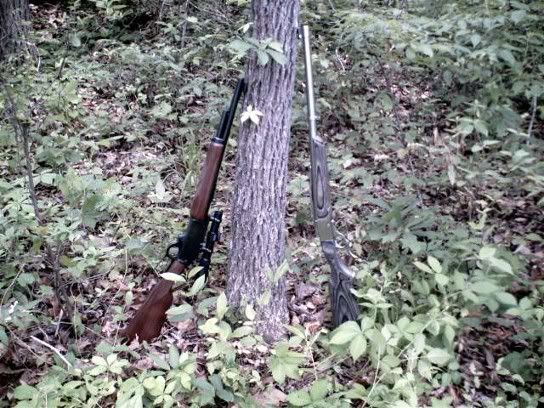
the cartridges and bullets
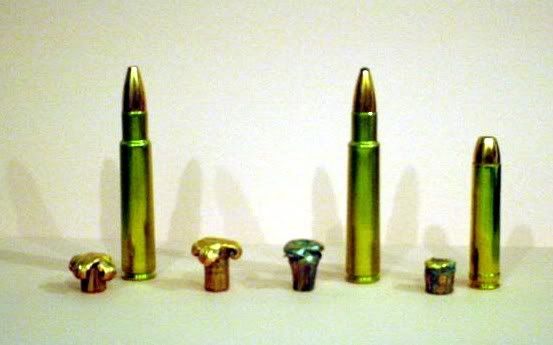
me with the 450
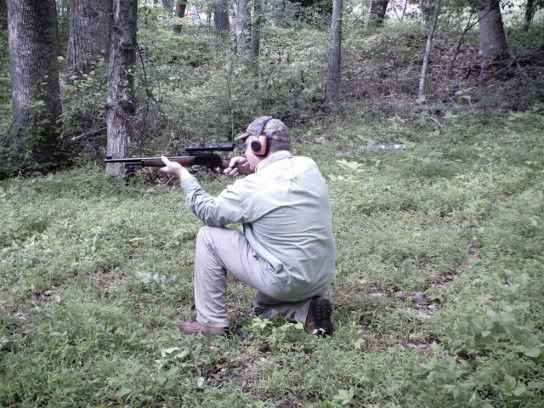
me with the .416
